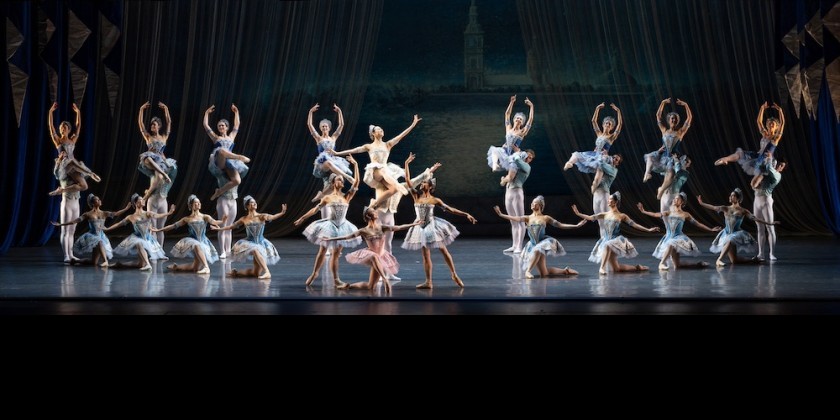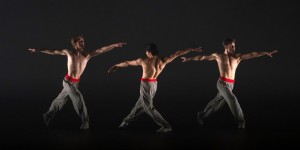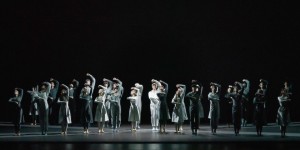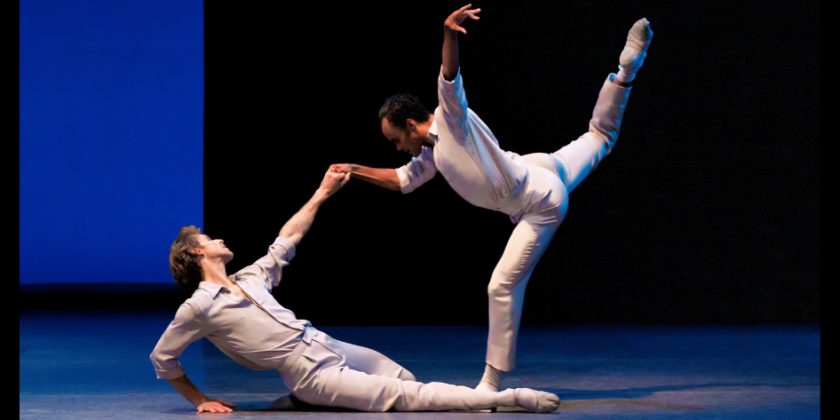IMPRESSIONS: American Ballet Theatre's Fall Season – Focus On George Balanchine's "Ballet Imperial"

David H. Koch Theater, Lincoln Center, New York City
Saturday, October 21 at 7:30pm
Sunday, October 22 at 2pm
Thursday, October 26 at 7:30pm
A long, glorious segment of Tchaikovsky’s Piano Concerto No. 2, Allegro Brillante e molto vivace, juxtaposing the sounds of a piano with wind instruments and horns, serves as an overture to George Balanchine’s Ballet Imperial. Then, the curtain rises on a grand ballroom. Open white drapes at the back of the scene frame a white palace in the distance on the far side of a blue river. Eight men in first position face eight women standing on their left foot (with the right resting behind them). Their diagonal lines have enough space dividing them that said river could run between from upstage right to downstage left. The women’s faces - visible to the audience (as are the men’s backs) – show anticipation but reserve. The female dancers raise their arms above their heads, yet the social setting implied by an elaborate chandelier hanging from the ceiling will not allow the women to traverse this room first.
Ballet Imperial, one of Balanchine’s most important tributes to his beginnings in the Russian imperial ballet, gives one time to soak in the atmosphere (and lets me ask myself if the sounds of the piano correspond to the inside of the ballroom while the wind instruments and horns suggest the outside). Then, the men cross the divide and bow to these ladies-in-waiting, who open their arms invitingly to their sides as their partners approach.

Scene from Ballet Imperial. Photo by Rosalie O’Connor © The George Balanchine Trust
The costumes sparkle in blue and white mirroring the colors of the set. The men and women bow to each other, and the men extend their right hands, which the ladies accept in unison. After a communal arabesque, every other couple in line step back downstage thus creating enough room for movement. The couples travel across the space together before some break off and arrange themselves in two lines of four couples each, which look like pillars supporting the architecture of the room on either side. Balanchine is not about to explore relationships here and adds eight additional women who repeat an ‘arabesque - port de bras’ pattern that the other women eventually join, but predictably all of the men end up with a woman on each arm. One understands that more important people will be introduced.
Indeed, the moment the newly formed threesomes assemble in a circle, a female soloist in pink runs in a snaking pattern half around each of them. She then gets to take centerstage and joyfully unfolds her limbs. The other dancers come together in two groups of twelve in identical pinwheel patterns, and eventually four ladies flank the soloist on each side with another eight women behind her and the men at the back of the stage. As groups of dancers join the soloist sequentially, the movement accumulates and its impact builds. Four women on one side follow the leader in a simple turn; and in the next rotation the four on the other side join in. Now the eight women behind them merge into the pirouetting ensemble before the men turn with the crowd. This passage simply yet effectively displays the excitement unity can create.

Patrick Frenette, Chloe Misseldine and Sung Woo Han in Ballet Imperial. Photo by Kyle Froman © The George Balanchine Trust
After the soloist impresses with fireworks and leaves, the corps form concentric circles, the men walking one way inside while the women bourrée in the other direction around them. The men depart, and the women walk in groups of four halfway across the room and back as if preparing for an important arrival. There she is: the czarina appears upstage right and enters the space. Her tiara is not the only thing that sets her apart. The territory is hers. The ladies look on from an open, diamond-shaped formation that allows the audience also to witness the extended solo in which no one else dares to join in. The admiration Balanchine had for Marie-Jeanne, the principal ballerina of this work and his lover at the time, must have been tremendous.
Reviewing a later version of the ballet (Balanchine revised some of his works multiple times), I mentioned that the premiere took place in Rio de Janeiro in 1941 (June 25) during a South American tour by Ballet Caravan. The work was also shown in an open dress rehearsal at the Little Theatre of New York City’s Hunter College four weeks before (May 29). Tchaikovsky also had tinkered with his original composition, or rather had his student Siloti try his luck with editing the concerto ; and Balanchine used Siloti’s version for his original ballet, as well as his major revision in 1973 for New York City Ballet, when he substituted the music’s title as the name of the ballet as well. Luckily for New York residents, we have both renditions; and American Ballet Theatre performs the original in a staging by Colleen Neary.
Both casts of ABT’s corps de ballet look glamorous. Sometimes one gets the feeling that the company breathes as one organism. Rather than the perfection of a military drill, however, the dancers feel and embody the beauty of Tchaikovsky’s music. ABT’s orchestra, under music director Ormsby Wilkins, interprets the score with room to breathe, and gives pianist Emily Wong the chance to play with passion. I love her performance on both Saturday and Thursday evening, but on Sunday afternoon genius takes possession of her and transforms this supposedly lesser of the composer’s concerti into a bright yet soulful masterpiece.

Skylar Brandt and Chloe Misseldine alternate in the soloist role. On Saturday, Brandt’s bravura dancing astonishes in its perfection. Her musicality mirrors the orchestra and I wonder if she should find a way to converse with the music. This is not a criticism, but rather an idea to allow a technically impeccable execution to be infused by surprise and wit. The young Misseldine bursts onto the stage with such joy and dances with such tremendous excitement that you forgive the movements of her mouth that might help her take in some air. Someone in charge must be less forgiving than I, and the minor affectation is gone by Thursday’s repeat performance. Her long limbs and the directional attack of her movements make her a natural for Balanchine’s choreography.
Isabella Boylston in the principal role might be somewhat stiff, but is technically adept and brings hauteur to the part. In difficult passages Boylston tends to ignore the music and focuses on the execution of steps. This has nothing to do with wit or surprise, but she carries out her task proficiently. Christine Shevchenko brings warmth, but should allow herself to be grander and take risks. She has a fine ear and solid technique. I bet if she would trust the movement and music to lead her, that her body would simply follow in response. Her second performance shows that improvement is likely to come every time she tackles this role.
When the ballerina leaves the stage, the soloist returns flanked by two other ladies in pink. Erica Lall and Betsy McBride in Saturday’s cast look as fine as Sunmi Park and Fangqi Li on Sunday and Thursday. The soloist and her attendants, and the corps of women fill the space with the physical equivalent of excited chatter before the trio run off. Then, the remaining women form a line at either side of the stage, opening the space as a man walks in and stands alone upstage center. It only takes a couple of bars of music for the ballerina to enter and cross the stage behind him and then cross the stage in front of him again. The moment the male dancer notices the ballerina proves significant for these performances at ABT. James Whiteside looks confidently out at the audience right until Boylston passes before his nose. It’s as if he has lost his sense of hearing as well as his peripheral vision. Calvin Royal III opens his right side in anticipation of Shevchenko’s arrival and moves his neck to let her know he has been waiting for her.

Calvin Royal III and Christine Shevchenko in Ballet Imperial. Photo by Emma Zordan © The George Balanchine Trust
The ensuing pas de deux reads on Saturday as a competition between Whiteside and Boylston for the audience’s attention rather than a duet in which the danseur noble serves his ballerina with devotion as Royal did on Sunday and Thursday. The special beauty of this segment is its privacy, for it is set to a long piano solo. Boylston and Whiteside are posing as public figures, and their frontal focus underscores the presentational nature of the ballet. Shevchenko chooses to be a benevolent czarina, and Royal is the man who adores her. They remind us that even blue blood pulses. Within the extended pas de deux there are long solo passages for the ballerina and short ones for her partner, so she can catch her breath. At least a couple of times in the duet the danseur noble is on one knee. Balanchine makes it clear: it is the ballerina who rules his world.
Once the two exit, the corps of sixteen women crisscross the stage and form symmetrical patterns. This scene appears both orderly and joyful, since classical ballet reflects Russian czarist glory and in this particular work one even gets the view of the Winter Palace. The women leave, and it’s time for another star turn for the soloist, this time with two men by her side. Brandt shines together with Carlos Gonzalez and Melvin Lawovi. Misseldine sparkles with Sung Woo Han and Jose Sebastian on Sunday, and Han and Patrick Frenette on Thursday. Yet the finale of the first movement belongs to the czarina, who now has the two female demi-soloists behind her each followed by a row of eight women. The men are in the back. Applause.
The beginning of the second movement has the ballerina leave through her entourage. Only a few women remain on stage, when the danseur enters from stage left. Has he arrived too late? Where is the ballerina? One gets the sense that Royal understands that this section is about her absence and his wish to be with her. Whiteside, on the other hand, enjoys his time looking at the audience. Both dancers make too much of leading around the strings of women who become attached to their arms. I experience a flashback to the time at ABT when Carlos Molina simply moved his arms in forlorn reverie and the ladies transformed into an extension of his poetic self in search of his beloved. Molina’s heart called out, and eventually his call was answered when the ballerina returned to his arms. Royal might be too polite, but I sense his longing. When he supports the ballerina in pirouettes that end in an arabesque, his gaze elongates the line of her extended leg and makes one believe that he does dream about her. It touches me.
The ensuing pas de deux full of tenderness between Shevchenko and Royal might just be a dream, for she disappears through a fog of women and he is left alone bowing to the empty stage.
The third and last movement is a happy one, which brings in a touch of folklore by way of recurring ‘hands-on hips’ for both women and men. This glorious finale shows off a company that has been reinvigorated by its new artistic director, Susan Jaffe. While New York audiences get to see plenty of Balanchine works at New York City Ballet, this original version is a keeper, and deserves its own production.

Gillian Murphy and Daniel Camargo in Frederick Ashton's The Dream. Photo by Rosalie O’Connor © The George Balanchine Trust
Frederick Ashton’s The Dream to Felix Mendelssohn’s music, compactly retells Shakespeare’s midsummer tale. Daniel Camargo deserves special mention and applause for taking on the role of Oberon in every performance of the season. Gillian Murphy and Cassandra Trenary star as Titania, Elwince Magbitang and an especially crisp Jake Roxander are spectacular as Puck, and Melvin Lawovi’s Bottom gives the program a delightfully comic itch.












